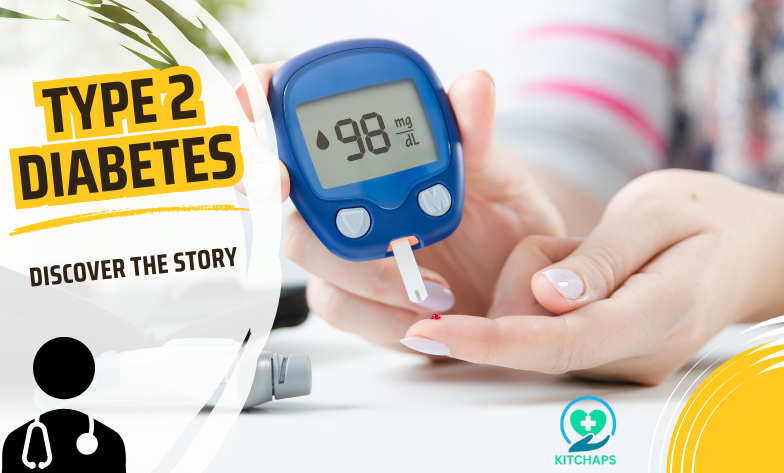Type 2 Diabetes is a remarkable health challenge. In 2024. IDF (International Diabetes Federation) estimated that 589 million adults in the world were living with diabetes, and 853 million by 2050. The cases of type 2 diabetes are 90%-95% which are evolving slowly. They are not diagnosing in half of the people. Early diagnosis, updated information, and its management are important for supervising it and protecting it from becoming severe.
In this blog, we will guide you through what type 2 diabetes is, its causes, symptoms, and much more.
Type 2 Diabetes: What is it?
It is a long-term metabolic disorder when the body becomes resistant to insulin. Sometimes, the body does not produce more insulin to balance levels of blood glucose. Type 1 diabetes is an autoimmune condition, and type 2 is related to lifestyle, genetics, and age. High level of blood sugar harms the blood vessels, important organs, nerves, and lead to some heart, kidney disease, as well as vision loss.
Causes: Why it Triggers?
The main reason behind it is that insulin resistance means cells in the body do not respond productively to insulin. The hormones of our body are responsible for regulating glucose. There are some key factors included:
- Obesity is mostly in the abdomen
- Reduce Physical activity
- Diabetes in family history
- Increase risk of diabetes after 45
- Ethnicities
- Gestational Diabetes
- Taking an unhealthy diet
Research points out that sleep health and gut microbiome trigger diabetes risks.
Symptoms: Recognizing Signs
It evolves slowly, and signs are absent in the early phases. So, perceiving the symptoms is very important for early prevention. Some of the common signs and symptoms are:
- Increases the craving for water.
- Constant Urination.
- Feeling of fatigue.
- Not a clear but blurry vision.
- Slow-healing wounds
- Unexpected weight loss.
- Numbness in hands or feet.
- Appetite increases.
- Darkening of skin in various areas.
Diagnosis: Type 2 Diabetes
Identifying it means measuring the glucose levels, but according to guidelines, listed below tests are common:
- FPG (Fasting Plasma Glucose): It is identified at >126 mg/dL after a night’s fasting.
- Hemoglobin A1C: It gives the average of blood sugar over 2-3 months and is identified at >6.5%.
- OGTT (Oral Glucose Tolerance Test): This identifies a two-hour value >200mg/dL.
- Arbitrary Plasma Glucose: Value of >200 mg/dL with definitive signs confirms it.
Type 1 vs. Type 2 Diabetes: Difference
| Characteristics | Type 1 Diabetes | Type 2 Diabetes |
| Triggers | Autoimmune destruction | Insulin deficiency and resistance |
| Age | Childhood or adolescence | Mostly adulthood, but in youth, it is more |
| Beginning | Suuden | Slowly |
| Insulin Need | Lifelong | It may not be required in the early stages |
| Frequency | 5-10% cases | 90-95% cases |
| Precaution | Not avoidable | Largely avoidable |
Prevention: Taking Control
It is preventable through lifestyle changes. Some new guidelines focus on the comprehensive approach:
- Balance your weight because losing 5-7% of weight reduces the risk.
- Do the exercise daily for a 150-minute moderate workout per week.
- Have a healthy diet full of grains, fruits, vegetables, proteins, and fats.
- Take less amount of processed food and sugar-added drinks.
- Getting a good sleep is identified as essential as diet and exercise for preventing diabetes.
- Quit smoking and limit the amount of alcohol.
- Check regularly if you have found any risk.
Conclusion
It is a complicated and chronic health condition. Proceeding in research and guidelines gives hope for early identification, its management, and some lifestyle changes. Always encourage yourself and others to take small steps every day.
Frequently Asked Questions (FAQs):
A. It is a long-term disease characterized by insulin resistance and high levels of blood sugar.
A. Yes, through eating a balanced diet, doing regular exercise, managing weight, and many other factors.
A. Type 1 is an autoimmune disease and needs lifelong insulin, whereas type 2 is insulin resistance and preventable by making some lifestyle changes.
A. Individuals with a family history and obesity are at higher risk for type 2 diabetes.
Disclaimer: The information provided is only for knowledge. It is not medical advice; always consult your doctor before taking medicine. Do not overlook the doctor’s medical advice because you have read it here.
Read more about:

